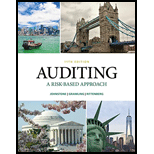
Introduction:
The term sufficient appropriate evidence explains that the evidence brought in is sufficient and appropriate enough to backup the conclusions arrived at and for the opinions formed by the auditor.
Requirement 1
To describe:
Explain the sufficient appropriate evidence and also how it distinguishes among the clients.
Introduction:
The type of
Requirement 2
To describe:
Explain about substantive analytical procedures and find out when the evidence collected in the procedures is appropriate.
Introduction:
Unique evidence challenges are those that support the truthfulness of the proposition made with valid evidence that is unique and true.
Requirement 3
To describe:
Explain the possible unique evidence challenges for the accounts like allowance for doubtful accounts. And also explain how the professional skepticism will be helpful during the testing of this account.
Introduction:
Document containing a checklist of questions that are to be asked while an audit, is called the Standardized Audit Program.
Requirement 4
To describe:
Explain with reasons as to how the standardized audit program could bring about problems listed out in PCAOB inspection reports.
Want to see the full answer?
Check out a sample textbook solution
Chapter 6 Solutions
Auditing: A Risk Based-Approach (MindTap Course List)
- Define the following terms below: A. Forensic Accounting B. Financial Accounting C. Auditing D. Fraud Examination E. Fraud Examiner F. Professional standards, legislation and regulatory requirements NB: Answer questions A-Farrow_forwardWhat should be the major emphasis in auditing the retainedearnings account? Explain your answer.arrow_forwardFinancial audit Q&A What is the file type of the customer confirmation that is related to the outstanding balance the client has?arrow_forward
- Define/explain following terms in your own words: 1). Compliance Audit 2). Difference between Auditing and Accountingarrow_forwardAuditing and Assurance Services T321 Which one of the following services provides a moderate level of assurance about the client's financial statements? Select one: O a. review O b. forecasts and projections O c. compliance O d. auditarrow_forwardChoose the documents which should be included in the audit documentation a. Summaries of significant matter O b. Issue memoranda O c. Audit program O d. All the optionsarrow_forward
- An item or information is said to be material if misstatement of which can influence the ___ a. Auditor's decision b. Audit committee's decision c. User's decision d. Management decisionarrow_forwardQ1- What is an audit? According to definition, what are the essential features of audit? Or Define auditing as per ISA 200. According to definition, what are the essential features of audit?arrow_forwardWhat type of audit report does a client typically want or hope for?arrow_forward
- Which assertion is most likely being tested when an auditor vouches transactions from the sales Journal to the sales orders? a. cutoff b. rights c. completeness d. accuracyarrow_forwardEnhanced the credibility of the information about a subject matter ( such as the financial statement) by evaluating whether the subject matter conforms in all material respects with suitable criteria A. Compilation services B. Assurance Services C. Agreed-upon procedures engagement D. Limited Assurance Servicesarrow_forward1. What are the evidence garthering techniques Used in Information System Auditing by Internat auditors? 2. What are the evidence garthering techniques Used in Information System Auditing by external auditors? 3. what is the different between Internal and external auditors and what privilleges do internal auditors has than external. 4. By answering these questions use accessible reference and provide their link for me to read after, prefereable references are from ResearchGate, IEE and other accademic repository. 5. Use intext citations.arrow_forward
 Auditing: A Risk Based-Approach (MindTap Course L...AccountingISBN:9781337619455Author:Karla M Johnstone, Audrey A. Gramling, Larry E. RittenbergPublisher:Cengage Learning
Auditing: A Risk Based-Approach (MindTap Course L...AccountingISBN:9781337619455Author:Karla M Johnstone, Audrey A. Gramling, Larry E. RittenbergPublisher:Cengage Learning Auditing: A Risk Based-Approach to Conducting a Q...AccountingISBN:9781305080577Author:Karla M Johnstone, Audrey A. Gramling, Larry E. RittenbergPublisher:South-Western College PubBusiness/Professional Ethics Directors/Executives...AccountingISBN:9781337485913Author:BROOKSPublisher:Cengage
Auditing: A Risk Based-Approach to Conducting a Q...AccountingISBN:9781305080577Author:Karla M Johnstone, Audrey A. Gramling, Larry E. RittenbergPublisher:South-Western College PubBusiness/Professional Ethics Directors/Executives...AccountingISBN:9781337485913Author:BROOKSPublisher:Cengage


